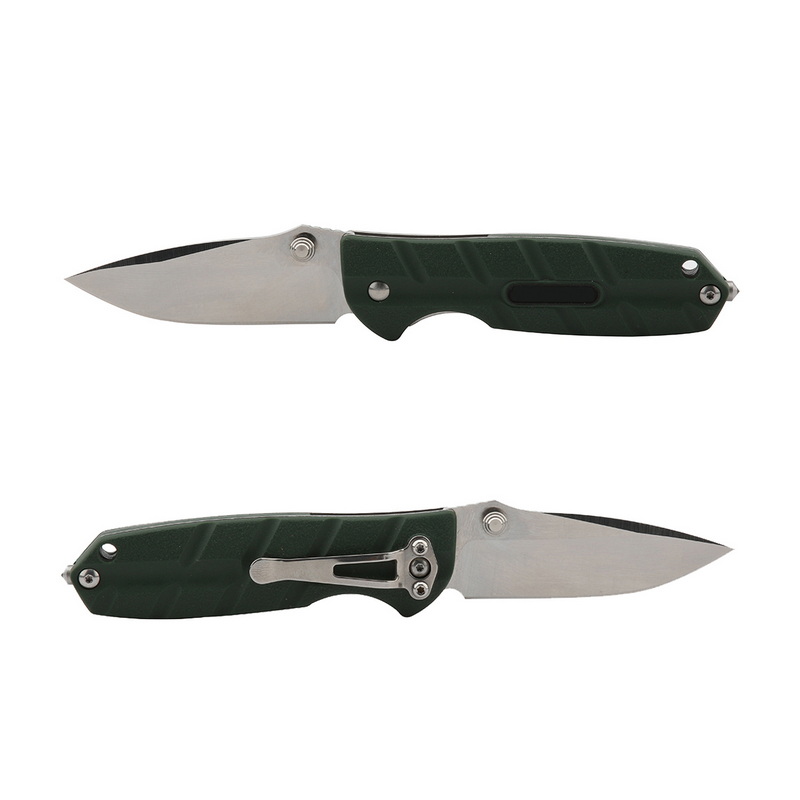![]() Windy
Windy
 WeChat
WeChat
 WhatsApp
WhatsApp
Click:345 seen
Lockback
Back locks (also known as rear locks, ridge locks, or center locks) are derived from non-locking joints. The lock bar is fixed to the blade, the turning point is in the middle, a spring bent behind the handle provides upward pressure behind the pivot point, and the press lock bar is in the front. In the latching position, the locking lever is located on a ramp at the bottom of the shank foot that provides a stop for opening.
When the blade opens, the front portion of the lock bar and its square protrusion, falls into the matching square cut at the top of the shank foot of the blade, locking it into place. The cut in the shank matches the shape of the lock rod, meaning that the lock rod must be lifted out of the recess. To release the blade. Therefore, the spring bar remains locked until the bar is subjected to the pressure of the spring tensioning cutter from behind the pivot point.
Pros: The backlock design is clever because the drive is done along the spine and does not cross each other, and the lock rod is usually much thicker than a typical liner lock and the same width as the blade itself.
Disadvantages: After repeated opening and closing, there will be a gap, resulting in abnormal opening and closing; Be careful when using with one hand.
Professional advice: Take care to regularly clean the fluff left on the square cut at the handle of the blade with a pocket screwdriver, compressed air, or a toothbrush to prevent locking difficulties.

Liner Lock
The interlock is a long strip of metal cut on the inner lining, which is bent at an Angle to the inner lining. The lock plate is responsible for locking the blade after the knife is opened against the base of the blade and the stop post and the spindle. When the folding knife is closed, the small steel ball on the lock plate will press firmly against the root of the blade to match the small groove of the steel ball, so that the blade can be fixed in the grip, and avoid the blade from popping out of the grip due to accidental collision.
Advantages: does not affect the appearance of symmetry, simple process, one-hand switch knife is easy, low price.
Disadvantages: The material of the lining is generally stainless steel or titanium, titanium is lighter and more rust resistant, but the wear resistance will be less.

Frame Lock
The frame lock is the most common form of folding knife lock after the liner lock. This structure is said to have been invented by Reeve, who tried to thicket the lock, but the problem of adding the patch to the lock was too thick, so he simply combined the thick wire lock with the handle concept. Its locking strength is generally stronger than the liner lock, because the lock sheet is thick and the friction surface is larger, making it more difficult to unlock. Ordinary knives are generally made of steel, and advanced ones are made of titanium metal, so that the overall weight is reduced. It is relatively thick on the side with the lock, forming the entire handle. There is an incision in the axis of the spine that relieves internal pressure. When the blade opens, the lock bar flicks inward against the back of the blade to lock the blade, and the stop ball engages with the hole at the bottom of the blade to keep it closed and provide tension to the strained opening. A stop pin mounted above and in front of the pivot determines the final position of the blade when opened and also helps to eliminate wear on the lock bar.
Advantages: Very strong, simple structure, few parts.
Disadvantages: Titanium is easy to wear, and the opening and closing depend on the pivot tension.

Compression Lock
The compression lock is considered to be an improved inverted liner lock, which was developed and patented by Spyderco. The blade will pop out along the ridge, and the hand will not be directly on the blade when it is withdrawn.
Advantages: Stronger than padded lock, ease of use.
Disadvantages: Precise machining required.
Professional advice: When adjusting the pivot tension, tighten the pivot pins on both sides as well, and then slightly loosen the stop pin (about a quarter) so that the blade can open and close more smoothly.

Axis Locks and Derivatives
The shaft lock is an interesting lock: steel bars pass through slots in the handle and lining, two "Ω" shaped springs provide equal tension on both sides of the bar, and stop pins position the blade for increased reliability.
Advantages: Easy to close, high strength.
Disadvantages: The spring is easy to break, easy to collect dust.
Professional advice: Pay attention to the spring of the locking mechanism on the drive shaft or similar device, if the lock begins to engage or disengage unevenly, it may be a signal that the spring is about to fail.

Button Locks
The button lock (or insert lock) is the opening and closing method of the automatic knife. When the blade is fully opened, the plunger (the round internal part of the button lock) engages with the notch on the shank foot of the blade.
Advantages: Strong locking force.
Cons: Difficult and expensive to manufacture.

Collar Lock
The ring lock is undoubtedly the most iconic French folding knife feature and is easy to operate: just twist the blade into the slot.
Advantages: Low cost, simple operation
Disadvantages: The collar or ring may harden over time, preventing smooth operation of the folding blade.
Professional advice: After long-term use, the ring needs to be maintained, if the rotation is too loose, please tighten with pliers. If it's too tight, use needle-nose pliers to pry some open and add some lube.

